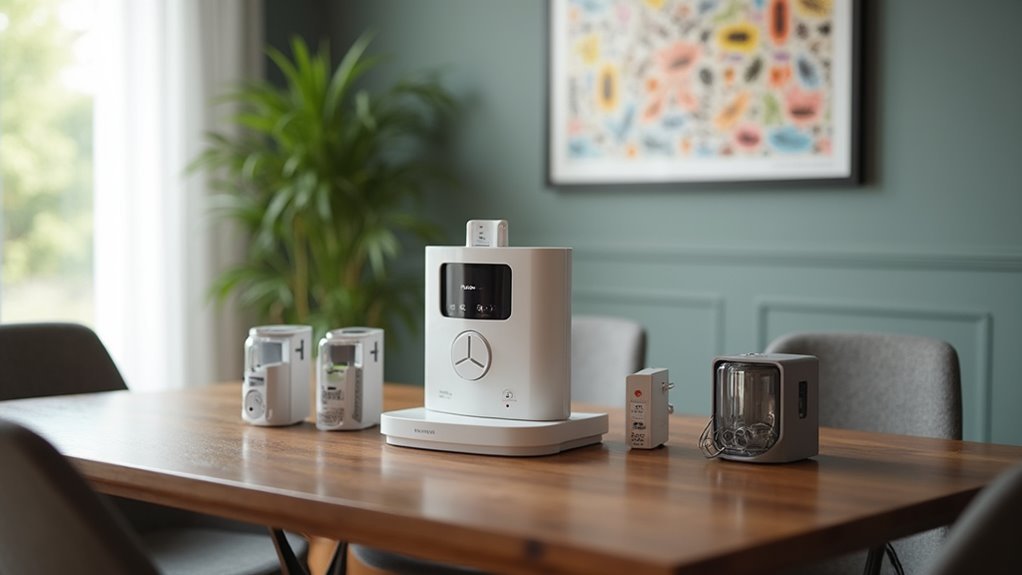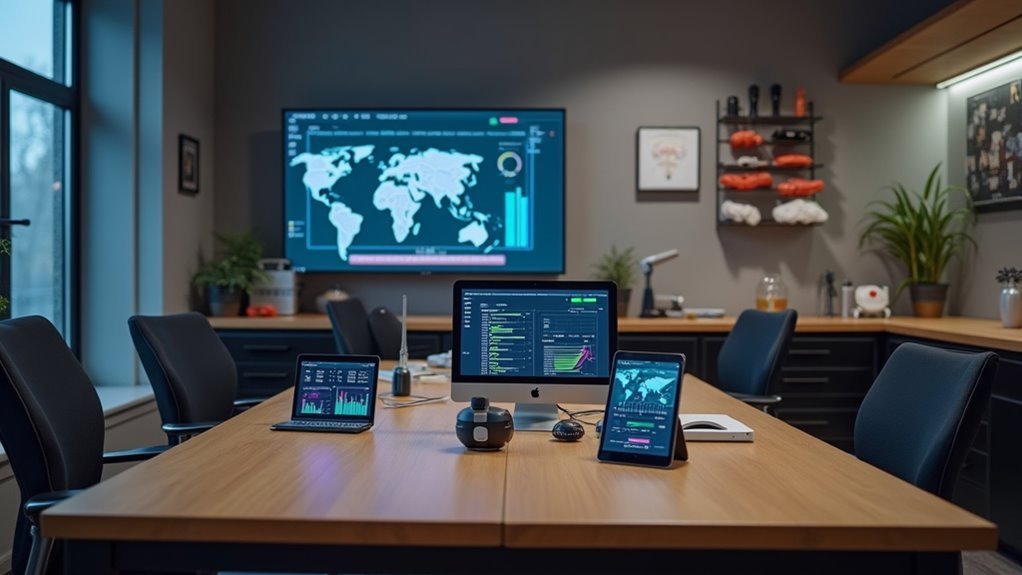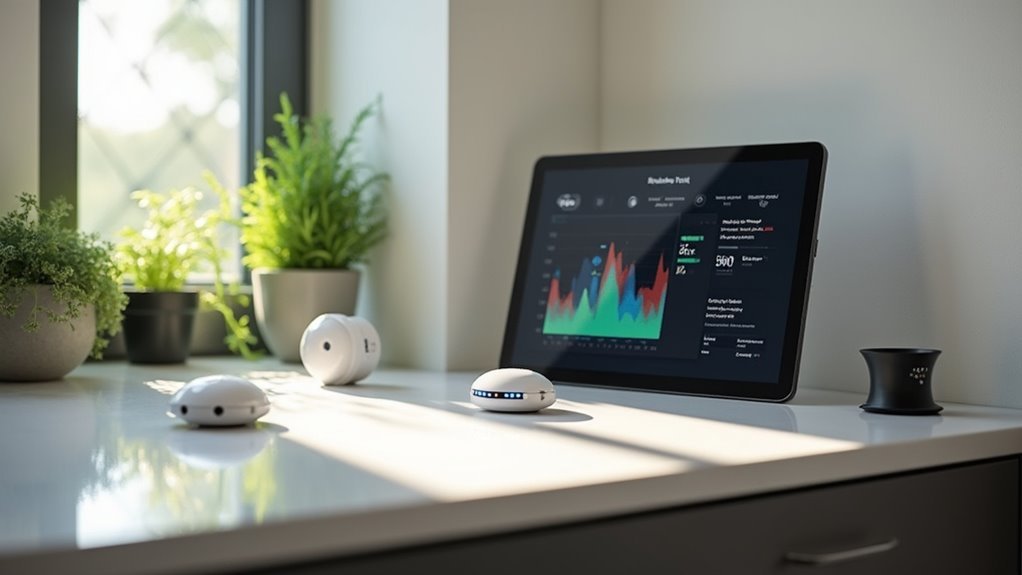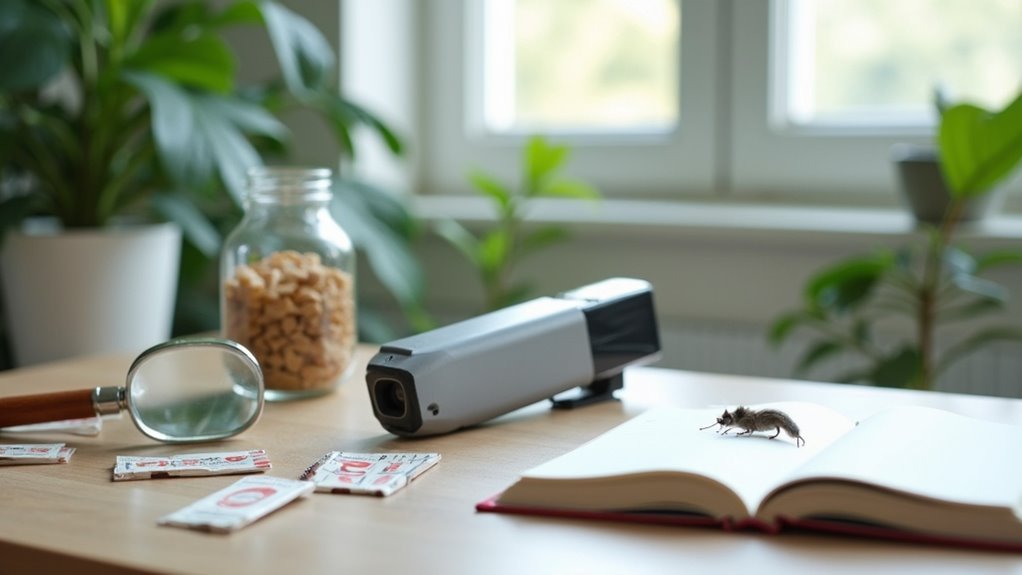You’ll create an effective indoor pest detection station by installing patented flight sensors and non-toxic traps at strategic locations like entry points, high-moisture areas, and food storage zones. Set up a central data hub with reliable Wi-Fi for real-time monitoring, then integrate AI-driven analytics to track pest activity patterns and seasonal variations. Regular maintenance and firmware updates guarantee peak performance while keeping your home safe from regulatory concerns. Discover extensive placement strategies and advanced monitoring techniques below.
Essential Components for Your Pest Detection System

When setting up an effective indoor pest detection system, you’ll need several key components working together to identify and monitor unwanted visitors in your space.
Start with monitoring traps like glue boards and bait stations to capture and identify pest activity. These essential tools form the foundation of thorough pest management strategies.
Consider investing in patented flight sensors that provide real-time insect population counts 24/7, enabling immediate response to emerging pest problems. Non-toxic traps guarantee resident safety while maintaining regulatory compliance for your detection system.
Position these components strategically near entry points and potential pest harborages where infestations typically begin. This targeted placement maximizes early detection effectiveness, particularly for termite protection and other serious pest threats requiring prompt intervention.
Strategic Sensor Placement Throughout Your Home
Where you position your sensors determines the success of your entire pest detection system. Place sensors near entry points like doors and windows where pests first infiltrate your home.
Strategic sensor placement at entry points like doors and windows is the foundation of any successful pest detection system.
Install them in high-moisture areas such as kitchens and bathrooms, as these environments attract ants, cockroaches, and flying insects seeking water sources.
Position sensors in food storage areas like pantries to catch pantry pests including moths and beetles before they damage your supplies.
Don’t overlook dark, undisturbed spaces like basements and attics where rodents and spiders commonly hide.
For effective pest control, regularly check and maintain your sensors to guarantee they’re operating properly.
This continuous monitoring provides timely alerts about pest activity, allowing you to address infestations before they become serious problems.
Setting Up Your Central Data Hub

Once you’ve positioned your sensors throughout your home, you’ll need to establish a central data hub that connects and manages all your monitoring devices. Start by ensuring you have reliable Wi-Fi coverage so sensors can report back their findings instantly. Your hub should integrate seamlessly with detection devices around the perimeter and interior spaces.
| Component | Requirement | Purpose |
|---|---|---|
| Wi-Fi Connection | High-speed, reliable | Real-time data transmission |
| Security Measures | Encryption, access controls | Protect sensitive data |
| Analysis Software | Visualization tools | Pattern recognition |
Install software that analyzes pest activity patterns, helping you understand when unwanted visitors head back to the nest. Regular system updates maintain accuracy and device compatibility, while robust security protects your data from unauthorized access.
Integrating Non-Toxic Traps With Monitoring Equipment
Strategic placement transforms your pest detection system from simple monitoring into an active, eco-friendly defense network.
You’ll integrate non-toxic traps with sensors that continuously track their effectiveness, providing real-time data on pest activity. This combination detects hidden infestations that traditional inspections miss while maintaining a safe environment for occupants.
Position sensors strategically around your non-toxic traps to monitor capture rates and identify high-activity zones. The monitoring equipment reports constantly, allowing you to reposition traps based on detected patterns for maximum efficiency.
Strategic sensor placement around traps provides continuous monitoring data, enabling pattern-based repositioning for maximum pest control efficiency.
This approach guarantees you’re complying with safety regulations while creating a healthier indoor space.
Your integrated system enables quick responses to pest presence through immediate alerts, transforming reactive pest control into proactive management that’s both environmentally responsible and highly effective.
Real-Time Data Collection and Alert Configuration

Smart sensors revolutionize pest detection by capturing continuous data streams that reveal activity patterns invisible to human observation. You’ll receive immediate notifications when pests trigger your monitoring equipment, enabling swift response before infestations escalate. Configure alerts to match your specific needs and schedule.
| Alert Type | Trigger Condition |
|---|---|
| Immediate SMS | High pest activity detected |
| Daily Email | Summary of 24-hour activity |
| Weekly Report | Trend analysis and recommendations |
| Emergency Alert | Multiple zones activated simultaneously |
AI-driven analytics continuously refine detection models, improving accuracy with each data point collected. You’ll make faster decisions about pest management strategies while reducing dependence on manual inspections. Smart technology integration enhances documentation capabilities, simplifying compliance tracking and regulatory reporting requirements for your indoor environment.
Analyzing Pest Activity Patterns and Trends
When your digital pest detection system accumulates data over time, distinct behavioral patterns emerge that reveal essential insights about pest populations in your indoor environment.
You’ll notice seasonal variations where certain species peak at specific times throughout the year, making continuous monitoring vital for effective prevention. By tracking frequency and types of insects detected, you can identify trends signaling potential infestations before they escalate.
Your system’s real-time data enables timely interventions based on observed activity levels.
Focus on understanding behavioral trends like peak feeding times and nesting habits to develop targeted treatment strategies. Historical data analysis helps you correlate environmental factors—temperature and humidity—with increased pest activity, allowing you to implement proactive management measures that prevent problems rather than simply react to them.
Proactive Response Protocols for Detected Infestations
When your detection station alerts you to pest activity, you’ll need to spring into action with predetermined immediate steps that prevent the infestation from spreading.
Your treatment selection should follow established guidelines that match the specific pest type and severity level detected by your monitoring system.
You’ll then need to adjust your monitoring protocols based on treatment progress, ensuring your response remains effective and adapts to changing pest behavior patterns.
Immediate Action Steps
Once your indoor pest detection station identifies unwanted intruders, you’ll need to act quickly to prevent a minor problem from becoming a major infestation.
Start by immediately identifying the specific pest type detected through your monitoring station. This identification enables you to implement targeted treatment strategies rather than generic approaches.
Next, use real-time data from your detection system to promptly notify pest management professionals. Swift professional intervention greatly improves control outcomes.
While waiting for assistance, document all pest activity details in your centralized tracking system.
Inspect your detection stations to verify they’re functioning correctly and providing accurate readings.
Finally, evaluate this detection event against your current protocols. Adjust your response strategies based on the pest type, frequency, and severity to enhance future control efforts.
Treatment Selection Guidelines
Effective pest management hinges on selecting the right treatment method for each specific threat your detection station identifies. You’ll need to match your response to the pest type for maximum effectiveness while maintaining safety around children and pets.
| Pest Type | Primary Treatment | Application Method |
|---|---|---|
| Cockroaches | Boric acid dust | Target cracks and crevices |
| Pantry pests | Pheromone traps | Place near food storage areas |
| Ants | Gel baits | Apply along trails and entry points |
| Flies | Sticky traps | Position near windows and doorways |
| Spiders | Residual sprays | Treat corners and hiding spots |
Document each treatment you apply in your centralized data hub. This tracking helps you identify which methods work best for recurring problems and adjust your strategy based on real-time monitoring results.
Monitoring Progress Adjustments
While your detection station identifies pest threats, establishing proactive response protocols transforms raw monitoring data into actionable interventions.
Digital monitoring systems provide real-time pest activity data, enabling immediate action when infestations are detected. You’ll need to regularly evaluate this monitoring data to identify trends and patterns, allowing strategic adjustments for peak treatment effectiveness.
Utilize non-toxic traps within your detection station to guarantee safe monitoring while minimizing chemical exposure.
Schedule routine inspections based on monitoring alerts to assess your current pest control measures’ effectiveness and make necessary strategy adjustments.
Establish a clear communication plan outlining how you’ll share pest activity data with all stakeholders. This guarantees everyone stays informed and can contribute to your proactive pest management efforts, creating a thorough response system.
Maintaining and Upgrading Your Detection Station
Your detection station’s effectiveness depends on consistent maintenance and timely upgrades to keep pace with evolving pest control technology.
You’ll need to establish regular cleaning protocols that prevent dust and debris from interfering with sensors while ensuring bait remains fresh and attractive to pests.
Consider upgrading to digital monitoring systems that provide real-time alerts and data collection, transforming your basic detection setup into a thorough pest management tool.
Regular Cleaning Protocols
Since dust and debris can quickly compromise your detection station’s performance, you’ll need to establish a monthly cleaning routine that keeps your equipment functioning at peak efficiency.
Use a soft, damp cloth to wipe down the station’s exterior, paying special attention to vents and openings that must remain unobstructed for proper airflow and pest access.
During each cleaning session, inspect for cracks, loose components, or other damage that could affect functionality.
Replace any worn glue boards or baits that have lost their effectiveness.
Dead insects and accumulated debris should be removed immediately as they interfere with monitoring accuracy.
Document each maintenance activity and record pest activity data in a log.
This tracking helps you identify patterns and determine when upgrades or strategy changes are necessary for ideal pest management results.
Technology Upgrade Options
As technology advances rapidly in the pest management industry, upgrading your detection station’s capabilities can dramatically improve monitoring accuracy and response efficiency.
Start by regularly updating your station’s firmware to access latest features and security enhancements. Consider integrating AI-driven analytics software that provides real-time insights and automates data interpretation, making it easier to identify pest activity trends.
Upgrade to sensors with enhanced sensitivity and broader detection ranges for improved accuracy in pest identification.
Explore modular expansion options that let you add sensors or monitoring devices to cover larger areas as your needs evolve.
Implement remote access capabilities to enable off-site monitoring and alerts, ensuring quicker response times and more efficient management of your pest control strategies.
Frequently Asked Questions
Can You Install Termite Bait Stations Yourself?
You can install termite bait stations yourself by following manufacturer instructions carefully. However, you’ll need proper placement, avoid kinked tubing, and maintain regular monitoring. Professional installation’s recommended for maximum effectiveness.
How Do I Create a Pest Control Program?
Start by evaluating your home for pest entry points and activity areas. Install monitoring stations to track infestations. Implement integrated pest management combining physical, biological, and chemical methods. Schedule regular inspections and educate household members.
Can I Do My Own Home Pest Control?
You can handle minor pest infestations yourself using DIY kits and products available online or in stores. However, you’ll need professional help for severe infestations or pests requiring specialized treatments.
How Effective Is DIY Pest Control?
You’ll find DIY pest control moderately effective for minor infestations, but it’s often temporary. Most homeowners experience re-infestation within a year since DIY methods don’t address root causes like professionals do.
In Summary
You’ve built an extensive pest detection system that’ll protect your home 24/7. Your strategically placed sensors, integrated traps, and real-time alerts work together to catch infestations before they become serious problems. You’re now equipped to analyze patterns, respond quickly to threats, and maintain your system for long-term success. Stay consistent with monitoring and upgrades, and you’ll keep your home pest-free year-round.





Leave a Reply